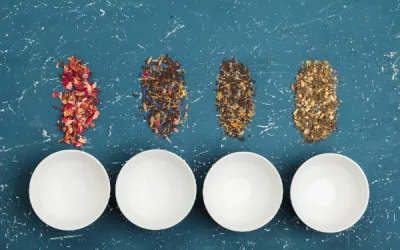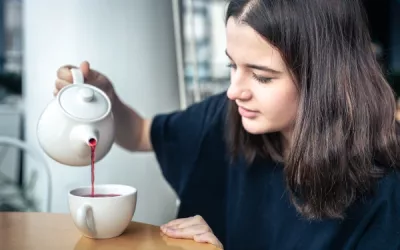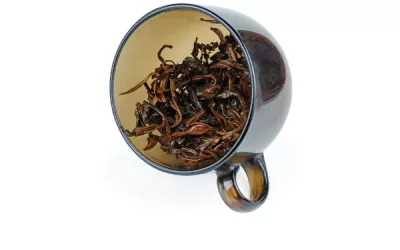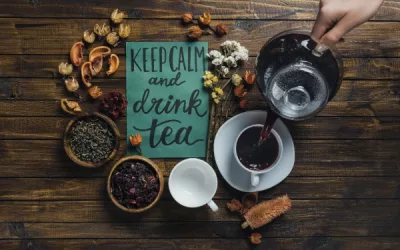Did you know that instant tea has been around for over a century, evolving from a simple convenience to a go-to beverage for busy professionals and health-conscious consumers? In today’s fast-paced world, understanding instant tea—its benefits, preparation methods, and diverse flavours—has never been more relevant. This article will guide you through everything you need to know about instant tea, comparing it to traditional brewed tea, exploring its health advantages, and helping you make informed choices for your next cup.
Table of Content
What is instant tea?
Instant tea is a modern solution for those who crave convenience without compromising on flavour. It’s a type of tea that dissolves quickly in water, allowing for a quick and easy beverage. The process begins with brewed tea, which is then dehydrated into a powdered or granulated form. When you add water—hot or cold—the tea is reconstituted to its original flavour and aroma. This makes it very different from the traditional tea that involves steeping loose leaves or tea bags.
Instant tea differs from brewed tea in several key ways. While traditional tea requires time and effort to steep, instant tea can be prepared in seconds, making it a go-to option for busy individuals.
Moreover, instant tea often includes various additives to enhance flavour and shelf life, unlike the more natural composition of brewed tea.
The historical context of instant tea dates back to the early 20th century. It gained popularity during World War II as a convenient way for soldiers to enjoy a cup of tea.
Over the years, technological advancements have refined the production process, making instant tea more flavourful and widely available.
Nowadays, you can find different types of instant tea, including black, green, and herbal varieties. Common ingredients often include tea extract, sugar, artificial or natural flavours, and sometimes preservatives. These elements ensure a long shelf life and consistent taste, making instant tea a reliable choice for many.
How does instant tea differ from brewed tea?
Instant tea and brewed tea are distinct in several ways. Understanding these differences can help you choose the right option for your lifestyle and taste preferences.
- Preparation Time: Instant tea is quick and easy to make, requiring only water. Brewed tea takes several minutes to steep properly.
- Ingredients: Instant tea often contains added sugars and flavours, while brewed tea is typically more natural.
- Shelf Life: Instant tea has a longer shelf life due to preservatives. Brewed tea is best consumed fresh.
- Versatility: Instant tea can be made with hot or cold water. Brewed tea usually requires hot water for proper extraction.
- Taste: Some argue that brewed tea offers a richer, more authentic flavour. Instant tea can sometimes taste artificial due to added ingredients.
Instant tea is perfect for busy professionals who need a quick pick-me-up. Its convenience is unparalleled, but if you’re a tea purist, you might miss the nuanced flavours of traditional brewed tea.
What are the main ingredients in instant tea?
The ingredients in instant tea play a crucial role in its flavour, aroma, and shelf life. Here’s a closer look at what you might find in a typical packet of instant tea.
- Tea Extract: The primary ingredient, usually derived from black or green tea.
- Sugar: Adds sweetness, though some varieties offer sugar-free options.
- Flavours: Can be natural or artificial, enhancing the tea’s taste.
- Preservatives: Extend the shelf life of the product.
- Anti-caking Agents: Prevent the powder from clumping together.
These ingredients make instant tea a quick and easy choice, but they also mean it might not be as pure as brewed tea. If you’re health-conscious, look for options with fewer additives and natural flavours.
Instant tea’s convenience makes it an appealing choice for many, but it’s essential to read the label if you’re mindful of what you consume. Health-conscious consumers often opt for brands that use fewer artificial ingredients.
What is the historical significance of instant tea?
The history of instant tea is quite fascinating and rooted in the need for convenience. It gained prominence during World War II as a quick and easy way for soldiers to enjoy tea. This period marked the beginning of instant tea’s journey into mainstream markets.
- Early 20th Century: Initial experiments with dehydrated tea.
- World War II: Instant tea became popular among soldiers.
- Post-War Era: Technological advancements improved the flavour and quality.
- Modern Day: Widely available in various flavours and types.
Instant tea has come a long way from its early days. The improvements in production technology have made it a staple in many households around the world.
During World War II, soldiers needed a quick and easy way to enjoy a comforting cup of tea, even in the midst of battle.
Instant tea provided this solution, offering a brief moment of normalcy in otherwise chaotic circumstances. The convenience and comfort it provided led to its continued popularity long after the war ended.
I remember my first encounter with instant tea during a hectic work week. Stressed and short on time, I discovered a packet in my office kitchen. It was a lifesaver, giving me a moment of calm amid the chaos.
Since then, I’ve kept a stash in my desk drawer for those particularly busy days. It’s not just about convenience; it’s about the little moments of joy it brings into a hectic day.
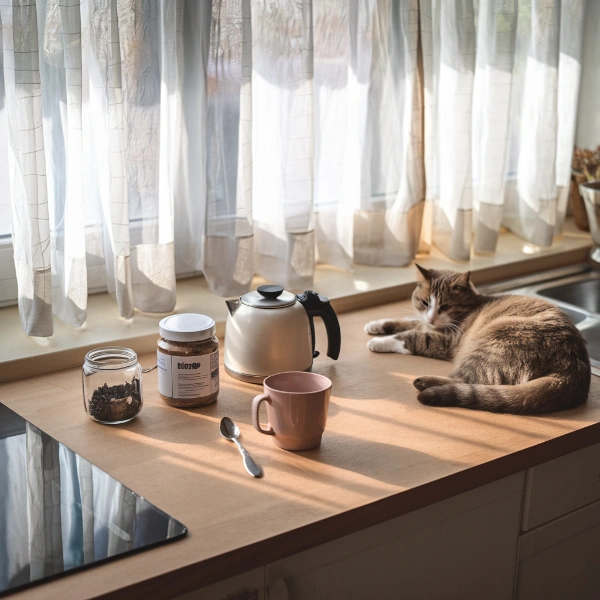
How is instant tea made?
Instant tea is an incredibly convenient beverage option, especially for health-conscious consumers and busy professionals. The process of making instant tea involves several steps, from selecting the raw materials to drying the final product. Here’s a detailed breakdown of how instant tea is made.
Understanding how instant tea is made can help you appreciate its convenience and quality. This table summarises the manufacturing process of instant tea, including the raw material selection, extraction methods, and drying techniques. Each row in the table represents a different step in the process, detailing the method and its significance.
| Step | Method | Significance |
|---|---|---|
| Raw Material Selection | Tea leaves are chosen | Quality of the final product depends on this |
| Cleaning | Leaves are cleaned and dried | Ensures impurities are removed |
| Extraction | Hot water extraction | Extracts flavours and nutrients |
| Filtration | Tea extract is filtered | Removes unwanted particles |
| Concentration | Evaporation process | Increases the tea extract’s concentration |
| Drying | Freeze-drying or spray drying | Converts liquid extract into powder form |
| Packaging | Powder is packed in containers | Preserves freshness and flavour |
Raw material selection
The quality of instant tea starts with the raw material. Manufacturers select high-quality tea leaves to ensure a premium final product.
- Tea leaves are the primary raw material.
- Quality depends on origin, type, and harvest time.
- The leaves are usually from Camellia sinensis.
- Organic and conventionally grown tea leaves are options.
- Proper selection impacts flavour and nutritional content.
Good raw material selection ensures the base flavour and health benefits of the instant tea. Without quality leaves, the rest of the process can’t compensate.
Cleaning and drying
Once selected, the tea leaves undergo cleaning and drying. This step is crucial to ensure only pure tea leaves are used.
- Leaves are cleaned to remove dirt and residues.
- Drying is done to reduce moisture content.
- It prevents mould and bacterial growth.
- Usually done through air-drying or oven drying.
- Prepares leaves for the extraction process.
Cleaning and drying are essential for maintaining the quality and safety of the tea. This step ensures that the leaves are ready for extraction without any contaminants.
Can instant tea contribute to daily hydration needs?
We all know we should be drinking umpteen glasses of water, but let’s be real, plain H2O can be dull. Enter instant tea.
- Fluid Balance: Provides necessary hydration, keeping you in tip-top shape.
- Electrolyte Inclusion: Some varieties incorporate electrolytes, which are perfect for post-gym sessions.
- Flavoured Options: Makes it easier to hydrate, given the plethora of flavours.
- Alternative to Sodas: Swap out sugary sodas for a refreshing, hydrating tea option.
Instant tea’s hydrating properties make it a solid contestant in the quest to drink more fluids.
In the early 20th century, tea was an exclusive beverage enjoyed by the upper class. However, with the advent of instant tea, the drink became more accessible.
An interesting story revolves around the Lipton tea brand. Thomas Lipton, a Scottish entrepreneur, revolutionised the tea industry by offering high-quality tea at affordable prices. His approach was to make tea accessible to everyone, and he succeeded by focusing on quality and convenience, much like how instant tea is produced today.
I remember the one time I tried instant tea. I was rushing to a meeting and didn’t have time to brew a fresh cup. I grabbed a sachet of instant tea, mixed it with hot water, and was pleasantly surprised by its rich flavour. It was convenient and tasted just as good as brewed tea, making it an essential part of my busy lifestyle ever since.
Is instant tea as good as regular tea?
Alright, let’s cut to the chase. When you’re brewing up a cup of instant tea versus a traditional tea, it’s like comparing a quickie in the microwave to a slow-cooked Sunday roast. Each has its own merits, but let’s break it down like a pro and see what we’re dealing with.
Traditional brewed tea is like that old-school mate who insists on wearing a suit and tie even to casual gatherings. It takes time to prepare, but oh baby, it’s worth the wait. Full-bodied flavour, aromatic, and that slight bitterness that makes you feel alive.
Instant tea? It’s that modern friend who shows up in comfy athleisure and gets things done in a flash. Quick, efficient, and just what you need when time’s not on your side.
What are the taste differences between instant and brewed tea?
When it comes to taste, instant tea and brewed tea might reside in the same neighbourhood, but they certainly live in different houses.
- Instant tea: Generally has a milder flavour, almost like tea-flavoured water. It lacks the depth and richness of brewed tea, and you might pick up a slight processed aftertaste. But hey, it’s not trying to win gourmet awards.
- Brewed tea: Rich, strong, and a full-on assault on your taste buds (in a good way). You can taste the earthiness of the leaves, the subtle notes depending on the variety – green, black, oolong, you name it.
So if you’re a connoisseur who likes to ponder life’s great mysteries over a cup, brewed tea is your go-to. If you just need that tea fix while juggling a million tasks, instant tea is your buddy.
How does the nutritional value compare?
Tea, whether instant or brewed, often touts its health benefits like a bodybuilder showing off at the gym. But do they stack up the same?
- Antioxidants: Brewed tea generally contains more antioxidants like catechins and polyphenols, which are great for your heart and might even help fend off some diseases.
- Calories: Both are typically low in calories unless you start dolling up with sugar and milk.
- Nutrients: Brewed tea retains more of its natural nutrients, while instant tea might lose some due to processing.
- Chemical residues: In some cases, brewed tea may have more residues from pesticides if the leaves aren’t organic. Instant tea generally goes through testing to meet safety standards.
So, if you’re all about those health benefits, brewed tea is like your overachieving health guru friend. Instant tea isn’t a slouch either but loses some points in the processing.
What do consumers prefer in terms of convenience?
This one’s a no-brainer, but it’s worth spelling out.
- Instant tea: Wins gold in the convenience Olympics. No faffing around with boiling water, waiting, and then removing the leaves. Just hot water, stir, and voilà!
- Brewed tea: Takes a bit more time and effort – heat the water just right, steep for the perfect duration, sometimes strain – it’s a ritual, alright.
- On-the-go: Instant tea can be taken anywhere – like a trusty sidekick. Brewed tea on the go? Slightly trickier unless you’re armed with a travel infuser.
- Storage: Instant tea is easier to store and has a longer shelf-life. No worries about your leaves getting stale.
For the busy professionals or anyone juggling life like a circus act, instant tea is a godsend. For the tea purists, the process of brewing is almost as enjoyable as drinking the tea itself.
You might be surprised to know that instant tea isn’t a modern invention. It first saw the light of day in the 1880s when a British entrepreneur, John Brown, sought a way to transport tea to British soldiers overseas.
The idea was to create a “tea brick” that could be brewed instantly, avoiding the hassle of brewing leaves. It’s like giving those soldiers their own little slice of Britain, no matter where they were stationed.
Today, you could say that convenience was built into the DNA of instant tea right from the get-go. Just a bit of history steeped in every cup!
So, is instant tea as good as brewed tea? Well, it depends on what you’re after – speed or savouring, convenience or ritual. Either way, pick your cup and drink up!
How do you prepare instant tea?
Instant tea, folks – the magical potion that lets you skip the brewing mystery and dive straight into “tea-time bliss” in seconds. Let’s dive into the nitty-gritty of making a perfect cup of instant tea that’ll impress even your pickiest relatives. And, trust me, there’s more to it than just pouring hot water!
First, you’ll need to measure the right amount. We don’t want your tea to taste like a flavoured swamp or bland water. Then, there’s the water temperature – scorching lava won’t do, nor will glacier-cold.
You need to get it just right. Next, we mix like a mad scientist, ensuring every granule dissolves. We’ve also got some tips up our sleeves to turn your instant tea into an irresistible elixir. Ready? Let’s get into it.
What is the ideal water temperature for instant tea?
The water temperature is crucial, my friend. Not too hot, not too cold; it’s a Goldilocks situation here.
- Optimal Range: Aim for around 80°C (176°F). Anything hotter and you’ll scald your tea… and probably your tongue.
- Avoid Boiling: Boiling water can ruin the delicate flavours and leave you with a bitter aftertaste.
- Warm but Not Tepid: Lukewarm water won’t dissolve the granules properly, leaving you with clumps – not the kind of surprise you want.
How much instant tea should be used per serving?
This isn’t rocket science, but get it wrong and you’ll have tea fit for the drain. Follow these guidelines and you’ll be golden.
- Standard Measurement: Use about a teaspoon of instant tea powder per 8 ounces (roughly 240 ml) of water.
- Adjust to Taste: More tea powder if you want a stronger flavour; less if you’re just after a hint.
- Keep it Consistent: Jot down your sweet spot so you hit the bullseye every time.
Are there any tips to enhance the flavour of instant tea?
Yes, indeed! You want your instant tea to be the Beyoncé of beverages, right? Here’s how to jazz it up:
- Citrus Kick: Add a slice of lemon or a dash of lime juice for freshness.
- Sweeten the Deal: Honey, agave syrup, or your favourite sweetener can work wonders.
- Spice it Up: A pinch of cinnamon, ginger, or cardamom can add an exotic twist.
- Chill Out: Try it iced for a refreshing change, especially in the heat of the summer.
So, there you have it! With these tips and tricks, you’ll elevate your instant tea game to a whole new level. Speaking of levels, did you know that instant tea actually got its major boost during World War II?
Yes, back when troops needed a quick, easy beverage, instant tea was a game changer. It wasn’t exactly a five-star brew, but hey, it did the job and kept the morale up.
So, next time you sip your perfectly prepped instant tea, savour the little bit of history in your cup.
What flavours of instant tea are available?
Oh, you’re in for a treat! The world of instant tea is vast, colourful, and downright delicious. From mainstream classics to obscure concoctions, instant tea has a smorgasbord of flavours to satisfy any palate.
Whether you’re a traditionalist looking for a cosy cup of Earl Grey or an adventurous soul seeking out the latest tropical blend, instant tea has got you covered. Now, let’s dive into the kaleidoscope of flavours that await you.
Instant tea comes in a range of popular flavours, unique blends, and seasonal offerings that can turn a simple morning routine into an exotic experience. From tangy fruit infusions to comforting herbal teas, the choices are as varied as a rainbow after a summer storm.
What are the most popular flavours of instant tea?
Alright, let’s cut to the chase. Here are the crowd-pleasers that have everyone buzzing.
- Classics like Green Tea and Black Tea never go out of style. They are the go-to’s for many because they’re like the dependable best friend you can always count on.
- Earl Grey and Jasmine Tea offer aromatic experiences that transport you to a luxurious Victorian sitting room.
- For those who prefer a bit of a fruity twist, Peach Tea, Lemon Tea, and Raspberry Tea are absolute hits.
- Chai Tea: This spicy blend of black tea, cinnamon, cardamom, and cloves is perfect for anyone needing a little warmth and richness in their cup.
These popular flavours have stood the test of time for a reason. They’re versatile, delicious, and offer a familiarity that feels like a warm hug on a cold day.
Are there any seasonal flavours available?
Absolutely! Think of instant tea flavours as the fashion of the beverage world. Just like your summer wardrobe differs from your winter one, so do the teas.
- Pumpkin Spice Tea: The autumnal favourite that’s essentially the drinkable version of your favourite pumpkin pie.
- Peppermint Tea: A refreshing winter delight, perfect for those chilly evenings.
- Apple Cinnamon Tea: Capturing the essence of fall with every sip.
- In the warmer months, you can’t go wrong with Mango Tea or Pineapple Tea, bringing a taste of the tropics right to your doorstep.
Seasonal flavours are like limited-edition gems. They only come around for a short while, so you can look forward to them every year.
Back in the 18th century, Catherine of Braganza, the queen consort of King Charles II, made tea drinking fashionable in the British court.
This act essentially popularised tea in Britain, leading to the country’s passionate tea culture today. Imagine if Catherine had access to instant tea—she might have introduced the realm to a whole new range of flavours, changing the tea game forever.
Are there any additives in instant tea?
You might be sipping on that convenient cup of instant tea and wondering, “What’s really inside this stuff?” Let’s cut to the chase – yes, instant tea often contains various additives. These aren’t just random ingredients tossed in for fun; they serve specific purposes. But are they good for you? And what should you be looking out for? Grab your cup and let’s dive in.
Instant tea can be a lifesaver, no doubt. Dump a spoonful into some hot water, give it a stir, and you’re sorted. But this convenience sometimes comes at a cost. With additives aiming to enhance flavour, appearance, and shelf life, it’s essential to know what you’re sipping.
What types of additives are commonly used in instant tea?
When cracking open a tub of instant tea, you might be surprised by the number of additives mingling inside. Here’s the lowdown:
- Artificial sweeteners: Think aspartame, sucralose, or saccharin. They provide sweetness without the calories.
- Preservatives: Sodium benzoate and potassium sorbate stop your tea from turning into a science experiment.
- Anti-caking agents: Silicon dioxide ensures your instant tea stays free-flowing and doesn’t clump together.
- Flavour enhancers: Natural and artificial flavours are added to make it taste more, well, like tea.
- Colours: Sometimes they add caramel colour or other dyes to keep your tea looking as good as it tastes.
How do these little helpers affect you? Let’s check it out.
How do these additives affect health?
Now, you’re probably wondering if these additives will turn you into a superhero or a couch potato. Here’s the skinny on their health effects:
- Artificial sweeteners: Generally safe in moderation, yet some folks fret about potential links to headaches or digestive issues.
- Preservatives: While preventing spoilage is cool, overconsumption of sodium benzoate has raised eyebrows for possible effects on immune function.
- Anti-caking agents: These are mostly harmless, but it’s worth noting that consuming large amounts of silicon dioxide isn’t recommended.
- Flavour enhancers and colours: Natural might be okay, but artificial options are a mixed bag. Some artificial colours have been flagged for allergic reactions or behavioural changes in kids.
What should consumers look for on labels?
Alright, detective, here’s what you should hunt for on those labels:
- Natural ingredients: Look for tea with natural flavours and colours.
- Low numbers on the ingredient list: Fewer preservatives and artificial additives indicate a purer product.
- Sweetener details: If sweetener is listed, prefer natural ones like stevia or avoid altogether if you can.
- Expiration date: Always double-check that freshness is at its peak.
Though labels can sometimes read like a chemistry textbook, keeping an eye out for these can save you some health woes.
Back in the 1840s, one savvy guy named John Walker Jr. took the hassle out of tea brewing by creating the first “instant tea”. This powder included sugar and sometimes milk for that ready-to-drink experience.
Revolutionising tea-drinking, Walker’s concoction became a hit among travelers looking for convenience. While the recipe and technology have evolved, the quest for convenience undoubtedly began with John Walker Jr.’s pioneering tea powder. Now, you know what’s potentially lurking in your modern-day version, and you can sip wisely.
Conclusion
As I bring this exploration of instant tea to a close, it’s clear that this convenient beverage option offers a wealth of benefits and insights worth considering.
We’ve examined the definition and unique characteristics of instant tea, highlighting how it differs from traditional brewed tea, particularly in terms of preparation and ingredients.
Its historical significance cannot be overlooked, revealing how instant tea evolved from a mere novelty to an essential choice for health-conscious consumers.
The manufacturing process, laid out in detail, underscores the craftsmanship involved behind this seemingly straightforward product.
With each step in production, from raw material selection to drying techniques, we can appreciate the dedication to quality that aims to deliver flavourful and health-promoting beverages.
Drinking instant tea presents remarkable advantages, not only for busy professionals seeking hydration but also for those interested in antioxidant properties and weight management.
While instant tea may not replicate the nuanced flavours of brewed tea entirely, it offers a convenient alternative without sacrificing too much in terms of health benefits. Understanding how to prepare instant tea properly allows us to maximise its potential, ensuring that each cup is both enjoyable and fulfilling.
With an array of flavours available, from classic varieties to innovative seasonal blends, instant tea caters to a diverse palate and even promotes health-focused options. However, it’s essential to remain mindful of the additives present in some products, fostering transparency around what we consume.
So where does this leave us? As I reflect on the journey through the realm of instant tea, I find myself considering how we can integrate this quick and satisfying beverage into our daily routines. Whether it’s with a morning ritual or an afternoon pick-me-up, there is plenty to ponder about the role of instant tea in our lives.
In the words of Ralph Waldo Emerson, “The creation of a thousand forests is in one acorn.” Perhaps, in choosing instant tea, we too can unlock potential—in convenience, health, and enjoyment. How will you embrace this little instant delight in your day?
Resources
- Widely targeted metabolomics reveals the effect of different raw materials and drying methods on instant tea
- Health effects of instant tea powder
- Molecular mechanisms underlying health benefits of tea compounds
- Is tea a healthy source of hydration?
- Green tea for weight loss and weight maintenance in overweight or obese adults
- Phenolic Content, Main Flavonoids, and Antioxidant Capacity of Instant Sweet Tea Powder
- Antioxidant Effects of Tea: Evidence from Human Clinical Trials
- Tea: hydration and other health benefits
- Tea and coffee powders


